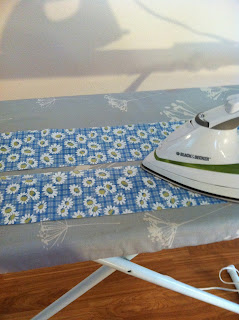I wanted to take a break from the projects I have been working on, and since I found the huge bag of yarn for $5 at the church's thrift shop, doodling seemed like a great idea! I am super excited about these because this is the first yarn I've worked with in a while that actually shows pattern well! No, seriously, when I post for the hoodie you'll understand why! Both of these are so super simple I can't even take credit for the patterns. So, I'll just list the patterns as patterns and say have fun!
Little Squares Trivet
needle size - 9.00 mm
yarn weight - worsted
gauge - 4x4" 12 st x 13 r
finished size - approximately 10 x 10 "
Using yarn from two skeins (or balls) of yarn, cast on 31 st. (I used one variegated and one solid.)
Knit 8 rows in garder stitch. (There should be 31 stitches in each row.)
Set 1:
Row 1: k5, p3, k3, p3, k3, p3, k3, p3, k5
Row 2: k8, p3, k3, p3, k3, p3, k8
Row 3 and 4: repeat row 1 and 2
Set 2:
Row 5: k8, p3, k3, p3, k3, p3, k8
Row 6: k5, p3, k3, p3, k3, p3, k3, p3, k5
Row 7 and 8: repeat rows 5 and 6.
Repeat sets 1 and 2 until approximately 8 3/4" long.
Knit 8 rows in garter stitch
** Last 2 stitches of last knit row, leave on needle:
Handle: k2, turn
repeat until there are 10 to 12 rows of handle. Cut yarn (at least 3"),
(with tapestry needle) sew handle to body, tie in ends.
Diamond Trivet
needle - 9.00 mm
yarn weight - worsted
gauge - 4x4" - 12 st x 20 r
finished size - approximately 15 x 20" (by diagonals)
Note 1: can make this pattern shorter by using fewer rows. End on even row.
Note 2: I changed colors on this one because I ran out of maroon yarn.
With yarn from two skeins (or balls) cast on 2 st.
Increasing:
Row 1: inc 1, knit to end, turn (3 st)
Row 2: inc 1, knit to end, turn (4 st)
repeat to row 6 (8 st)
Row 7: inc 1, k2, p1, k4, turn (9 st)
Row 8: inc 1, k to end, turn (10 st)
Row 9: inc 1, k2, p to 4 from end, k4, turn (st in row = row # + 2)
Row 10: inc 1, k to end, turn (st in row = row # + 2)
repeat rows 9 and 10 until there are 50 stitches on one needle (end on even row # 48).
(can change yarn here)
Decreasing:
Row 1: k2tog, k3, p to last 4, k4, turn (49 st)
Row 2: k2tog, k to end, turn (48 st)
repeat rows 1 and 2 until there are 2 st on needle. (decreased st by one on each row)
Last row (without handle): k2tog, cut yarn (3-4"), tie in ends.
Optional handle:
Last row is first handle row: k2, turn
repeat until there are 10 to 12 handle rows, cut yarn (3-4"), sew handle to body
(with tapestry needle), tie in ends.


















